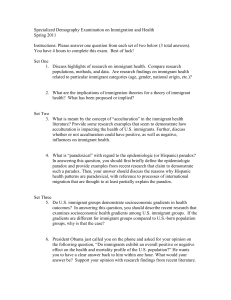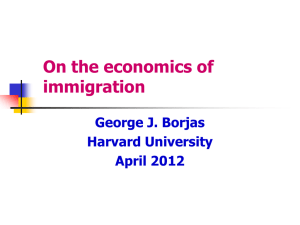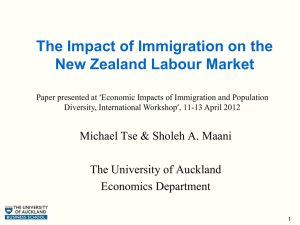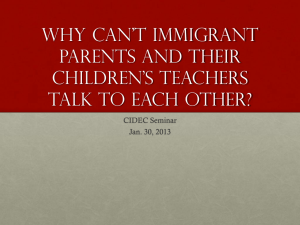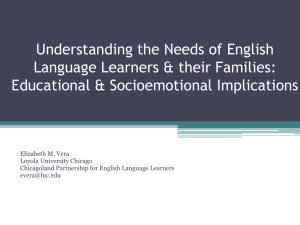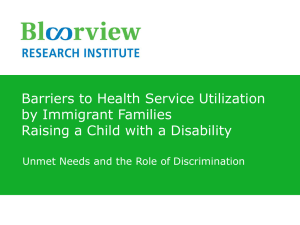Educating Immigrants - Vanderbilt University
advertisement
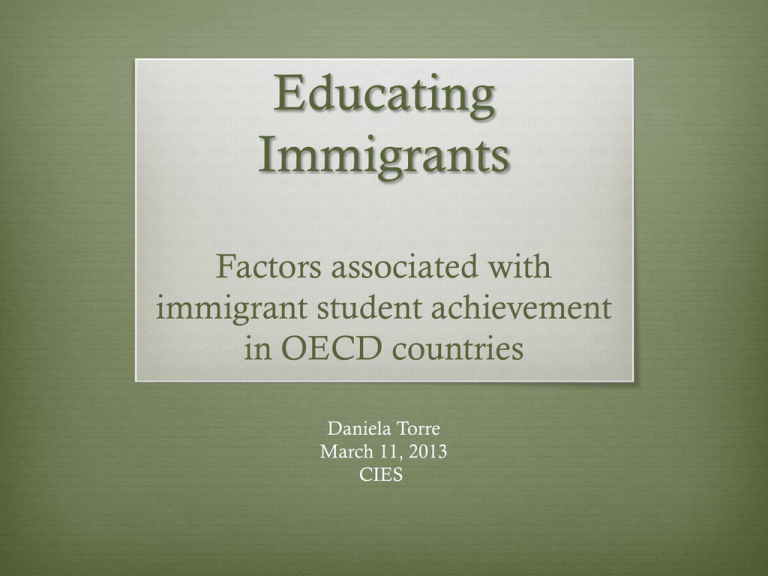
Educating Immigrants Factors associated with immigrant student achievement in OECD countries Daniela Torre March 11, 2013 CIES Problem “Non-immigrant students outperformed immigrant students by more than 40 score points on both the 2000 and 2009 PISA assessments” (OECD, 2012). Immigrant students are more likely to drop out of high school. (Alba, Sloan & Sperling, 2011). Among In no OECD doonly immigrant students enjoy an OECDcountry countries, Australia, Canada, the Czech The achievement gap between immigrant and non-immigrant Republic, and Israel show no overall performance advantageHungary over non-immigrant student (OECD, 2012) students varies across country (OECD, 2012) differences between students by immigrant background (OECD, 2012) Why is it important to teach immigrants well? Growing demographic (Joppke, 2007) Human capital development (Joppke, 2007) Social Cohesion a common national identity built via the development of common values, shared symbols, shared ceremonies (Cheong Edwards, Goulbourne & Solomos, 2007) “ability for a community to withstand exogenous shock without turning on itself ” (Heyneman, 2003) Schools contribute to social cohesion: • by teaching norms of the society • by bringing people form different backgrounds in contact with each other • by treating all students fairly • by building a common ground defining citizenship for diverse groups of people (Heyneman, 2003). Research Question What student, school, and country factors are related to the academic achievement of immigrant students? Student Country School Student Factors Language used in the home PISA results show that students who do not speak the language of instruction at home are on average one year behind native language speaking peers. (Christensen, & Stanat, 2007). About 50 points for first generation students, 35 points for second generation students. Reading scores by percentage of students in school who do not speak test language Student Factors Reason for Immigration (OECD,2012) Work Related Forced migration Refugees &Asylum-seekers Family reunification Student Factors Generational Status Differences between 1st or 2nd generation According to PISA results, second generation students tend to perform no differently or better than first generation (OECD, 2012) “disadvantage may be maintained across generations due to lack of language proficiency, limited social networks, or physical distance from the majority culture” (Szulkin & Jonsson, 2007). U.S. example Age of entry Length of time in country associated with increased achievement (Zinovyeva, Felgueroso, & Vázquez, 2008; Schneeweis, 2009 ) Student Factors Socio economic status USA, Canada, and Australia Race/ Ethnicity “When it comes to immigration in the global era, race and ethnicity, along with class and gender, continue to matter. They matter, first and foremost, because the majority of immigrants are from the non-European, non English-speaking ‘developing world’” (Suarez-Orozco): Parent education Explains about 25% of the difference between the outcomes of immigrant and non-immigrant students; however this varies by country. (OECD, 2012) School Factors Tracking Immigrant students overrepresented in lower tracks (Alba, Sloan, & Sperling, 2011) Age that student is tracked makes a difference “The earlier that students are tracked, the greater the influence of social background characteristics on their educational trajectories” (Van de Werfhorst & Mijs 2010). Germany vs. France School Factors Concentration of immigrant or disadvantaged students Students who attend more segregated schools have lower achievement (Zinovyeva, Felgueroso & Vázquez, 2008) “Immigrant children’s performance in PISA is more strongly (and negatively) associated with the concentration of educational disadvantage in schools than with the concentration of immigrants per se or the concentration of students who speak a different language at home than at school.”(OECD, 2012) “Poor, low-skilled immigrants of color have few options other than to send their children to schools located in drug-, prostitution-, and gang-infested neighborhoods. All too many schools attended by poor immigrant children today can only be characterized as sites overwhelmed by a “culture of violence.” Many newly arrived immigrant youth find themselves deeply marginalized in toxic schools that offer inferior education.” (Suarez-Orozco, 2001) School Factors Language Support Program Immersion Immersion with support Immersion with preparatory phase Transitional bilingual Maintenance bilingual (Christensen & Stanat,, 2007). Teacher capacity Quality of curriculum Country Factors Alignment between country of origin and destination country Language alignment with destination country Familiarity with educational system Social welfare programs France and Sweden: students begin schooling at age 3. National health care Childcare provision Country Factors Immigration Policy Canada, Australia, and New Zealand see smaller gaps between immigrant and non immigrant students. These nations have strict immigration polices that target highly skilled immigrants who have adequate language proficiency. (Christensen & Stanat, 2007). Income and housing requirements may have unintended consequences. Conclusion Context matters Build bridging social capital Change has to be systematic “The biggest obstacle is quite simply that governments and schools must commit to systematic language support from kindergarten through secondary school. These programs must be a long‐term investment and not a short‐term reform.” (Christensen & Stanat, 2007) Implications Provide support for immigrant students at all school levels Train teachers Provide specialized curricula based on language development frameworks Provide intensive language support, followed by long term language support. Type of language support not as important as strong implementation. Promote interaction between immigrant and non immigrant students- ie, housing policies, school choice. Next Steps Investigate how immigration patterns have changed over the last 20 years and how those changes are related to student achievement. Investigate how social welfare policies and immigration policies are related to immigrant student outcomes. Daniela Torre Vanderbilt University daniela.torre@vanderbilt.edu

